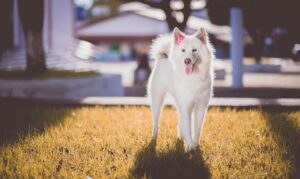Introduction
The Akita dog breed is known for its noble appearance, fearless nature, and unbreakable loyalty. Originally bred in Japan to guard royalty and hunt big game, the Akita has become a beloved companion and protector in households around the world. This guide will walk you through everything you need to know about the Akita dog breed—from history and physical traits to grooming, training, and health.
Breed Overview
| Trait | Description |
|---|---|
| Origin | Japan |
| Group | Working Group |
| Height | 24 – 28 inches (61 – 71 cm) |
| Weight | 70 – 130 lbs (32 – 59 kg) |
| Lifespan | 10 – 13 years |
| Temperament | Loyal, Protective, Calm |
| Coat Type | Thick, double coat |
| Energy Level | Moderate |
| Trainability | Moderate to Difficult |
| Grooming Needs | High during shedding seasons |
| Good with Kids | Yes, with supervision |
History of the Akita Dog Breed
The Akita dog breed dates back more than a thousand years, originating in the snowy mountains of Japan’s Akita Prefecture. These dogs were initially used for guarding royalty and nobility, as well as hunting bear, boar, and deer. Akitas are a national treasure in Japan and symbolize good health and protection.
There are two main types:
Japanese Akita Inu – Slimmer build, more fox-like features
American Akita – Larger frame, bear-like face
Appearance & Physical Traits
Akitas are large and muscular, giving them a striking and powerful appearance. They have a broad head, erect ears, and a curled tail. Their dense double coat protects them in cold weather. Akita colors include white, brindle, red, sesame, and pinto.
Akita Temperament and Personality
The Akita dog breed is known for being reserved but affectionate with family members. Key traits include:
Loyalty: Bonds strongly with one family
Protectiveness: Natural guard dog instincts
Independence: Can be strong-willed and stubborn
Quiet Demeanor: Doesn’t bark unnecessarily
Akitas may not be ideal for first-time dog owners due to their dominant personality.
Is the Akita Right for Your Home?
Akitas thrive best in certain environments:
Space: Not ideal for apartment living unless properly exercised
Family: Better with older children and experienced dog owners
Other Pets: Prefer single-pet homes due to same-sex aggression
For a calm and stable household, the Akita is a rewarding companion.
Training and Socialization
Start early and be consistent. Akitas respond best to positive reinforcement and clear leadership.
Socialize early: Introduce them to different people and settings as puppies
Leash training is essential
Avoid harsh punishment: Use reward-based training
Check out our Signs of a Healthy Pet guide to ensure your Akita stays in peak condition.
Nutrition & Feeding
Akitas require high-quality food formulated for large breeds.
Feeding Guidelines:
2 meals/day to prevent bloating
Avoid heavy exercise before or after meals
Include protein, healthy fats, and complex carbs
Learn more in our Dog Nutrition Guide.
Exercise Needs
While not overly energetic, Akitas need daily activity to stay healthy and prevent boredom.
2 walks per day
Mental stimulation: Puzzle toys and obedience games
Secure outdoor space for exploration
Grooming and Shedding
Akitas shed heavily, especially during seasonal coat blows.
Grooming Tips:
Brush daily during shedding season, weekly otherwise
Bathe every 6–8 weeks
Trim nails monthly
Clean ears and brush teeth regularly
Common Health Issues
Like many large breeds, the Akita dog breed is prone to:
Hip Dysplasia
Hypothyroidism
Progressive Retinal Atrophy (PRA)
Autoimmune disorders
Gastric Dilatation-Volvulus (bloat)
Always consult your vet and consider regular screenings. See our guide on When to Visit the Vet for more.
Pros and Cons of Owning an Akita
Pros:
Fiercely loyal and protective
Quiet and clean
Stunning appearance
Low odor
Cons:
Not always friendly with other pets
Needs confident, experienced handlers
Heavy shedding
Prone to stubbornness
Fun Facts
Hachikō, Japan’s most loyal dog, was an Akita who waited at a train station every day for his deceased owner—for over 9 years.
Akitas are often given as gifts in Japan to symbolize health and good fortune.
Final Thoughts
The Akita dog breed is not for everyone—but for those who understand and respect its strong personality, it is one of the most devoted and majestic companions imaginable. With proper care, training, and affection, your Akita will be a guardian and friend for life.

Learn more about how to choose the best dog for your lifestyle in our Dog Breed Selection Guide.







